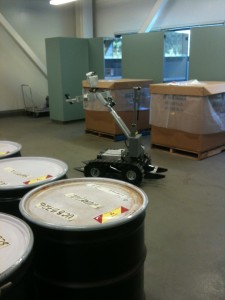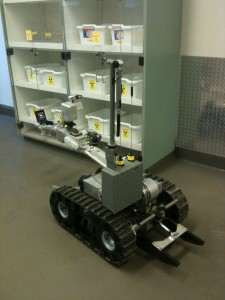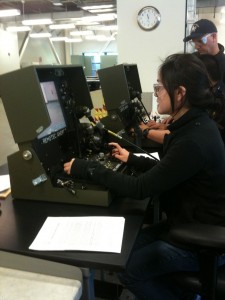The other half of last week’s fun was responding to a request from UC and Berkeley Police Departments to assist them with some training for their bomb squad unit. While they’re quite familiar with what to do with explosives, they wanted to get some practice in with radioactive sources just to work on potential “dirty bomb” responses. Seeing as how I’m the guy with interesting materials at my disposal and have been The Radiation Guy Who Talks To Cops, I got a call.

I set up a nice obstacle course for them to drive the robots through, with some of my favorite sealed sources tucked away out of view behind a whole bunch of waste drums. On the other side of the building, I had the large Cs-137 source put out on the instrument calibration range. Their mission: starting in the middle of the room, head toward the drums and find the sources I’d hidden over there and then drive all the way back to the other end of the room and identify the radioactive source.
Did I mention that over beyond the drums was a somewhat non-descript large cardboard tri-wall box full of uranium/thorium waste? No? Hmm, I failed to mention that to the bomb squads too for some reason.

The purpose of test one was a sandbagging exercise to see if I could distract them with shiny, well labeled items to the point that they ignored the very evident higher radiation fields from the cardboard box full of thorium and uranium. The did find my check sources, but when asked them what the dose rate was, they let me know that it was only .3mR/hr but it was a bit higher a bit back. I just kind of stood there quietly while they listened to their own words. They then backed the robot up and went inspecting the box. When I was asked what the hell was in there, I said that I was pretty sure that they had cameras on that robot that could look for identifying information rather than deploying a dearly precious technician to go read the paperwork.
On the return trip for a look at the large Cs-137 source, I had my technician leave all the transport containers over there, easy to be seen by the camera. The operator homed in on the larger transport container and was rather to disappointed to discover it was empty. I asked him if, like the sealed source, that was the highest field he’d seen. He began searching again and found a lead container that looked suspiciously like it fit inside the larger one.
I had my technician open it up and show the interior to the camera. Empty. The operator grumpily resumes searching.
After five more minutes, he shows me a picture of the calibration stand and says it is somewhere on there. I ask what, specifically, was the source. He opens his mouth, begins to point at the screen, stops, hangs his head and says, “I don’t know. I have no idea what it looks like.”
I gave him a hearty clap on the shoulder and congratulated him on saying the three hardest words in the English language for people in authority. I then had my technician point at the very, very small,unmarked, quite unobtrusive bullet of metal. Radioactive sources don’t necessarily look like anything. Packaging and labeling is what you look for to indicate something is missing or has gone wrong, but the actual source itself may take some finesses with a meter to find. If it is a rather large source, all you’ll really be interested in doing is defining an exclusion area to keep people out of due to high dose rate.
When we were finished with the exercise, I told them all it was about time to pack up their gear. As the officer went to reach for the instrumentation case, I told him, “Uh uh. What do you think you’re doing, officer?”
With some confusion, caught mid-motion of picking up the case, he slowly replied, “Packing…up…our gear?”
I crossed my arms and felt a smirk I remember all too well from the faces of some of my radtech trainers. “Not that way. You have a perfectly good robot to pack all of that with. Reload your cart using the robot.”
The look I got from him will still be treasured when I’m retired and sitting on the porch in my rocking chair. He then nodded and said, “You’re nastier than the FBI was.”
When they finished, I asked the sergeant how often they practiced with these units. His answer: “Not often enough. This has been a serious workout.” I asked if the police, or the City, held picnics or BBQs where they were present. He nodded as if I were a ninny that hadn’t paid attention to the civic calendar ever.
I told him, “Okay, then there is no reason why the Bomb Squad robot isn’t there serving beer and soda to people. I mean, c’mon, it’s a frickin’ robot, guys! This is a goodwill goldmine in a way that a K-9 unit never will be. It is a chance for you to practice while impressing the bejeezus out of kids. Also, make sure to check if your manipulator arm will crush a beer bottle first. Important safety tip.”
As we were loading everything back into the truck I gave them my take home message, which is very similar to that I’ve been giving for Fukushima reactor problems: never forget the latency of what you’re working with. The explosive will always take priority over the radioactive material as the kaboom will kill you dead immediately. I can always decontaminate things and people later; it may not be quick, it definitely won’t be cheap, but cleaning up rad is what people like me are for. What I can’t do is unexplode people, which is why we have a Bomb Squad.

So, if you’re at some future Berkeley civic function where beverages might be served, look out for your friendly robo-server and say hello to the guys driving it. They’re fun guys doing a tricky job, though a bit PR-impaired, bless their hearts.